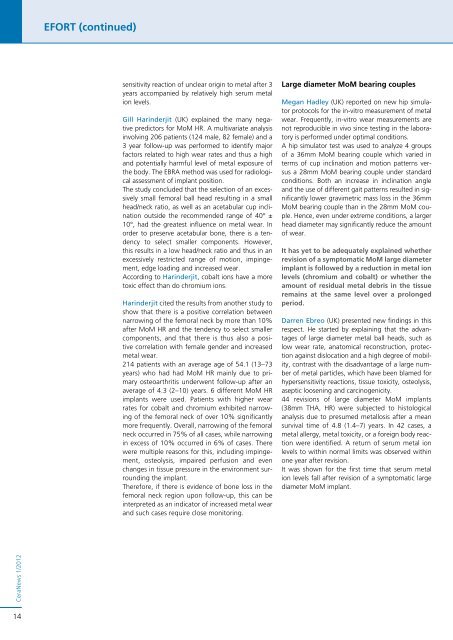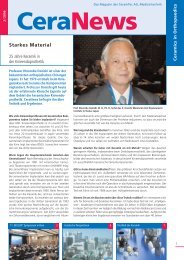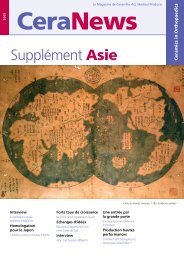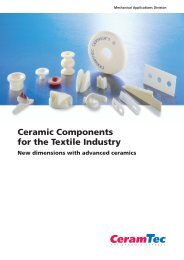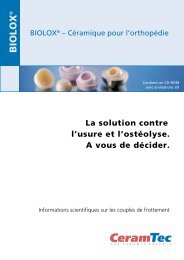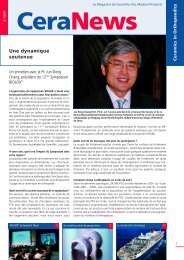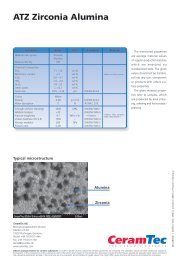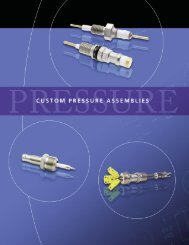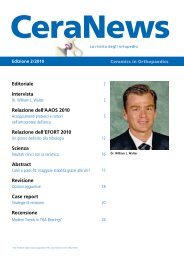Download PDF, 2.4 MB - CeramTec
Download PDF, 2.4 MB - CeramTec
Download PDF, 2.4 MB - CeramTec
You also want an ePaper? Increase the reach of your titles
YUMPU automatically turns print PDFs into web optimized ePapers that Google loves.
EFORT (continued)sensitivity reaction of unclear origin to metal after 3years accompanied by relatively high serum metalion levels.Gill Harinderjit (UK) explained the many negativepredictors for MoM HR. A multivariate analysisinvolving 206 patients (124 male, 82 female) and a3 year follow-up was performed to identify majorfactors related to high wear rates and thus a highand potentially harmful level of metal exposure ofthe body. The EBRA method was used for radiologicalassessment of implant position.The study concluded that the selection of an excessivelysmall femoral ball head resulting in a smallhead/neck ratio, as well as an acetabular cup inclinationoutside the recommended range of 40° ±10°, had the greatest influence on metal wear. Inorder to preserve acetabular bone, there is a tendencyto select smaller components. However,this results in a low head/neck ratio and thus in anexcessively restricted range of motion, impingement,edge loading and increased wear.According to Harinderjit, cobalt ions have a moretoxic effect than do chromium ions.Harinderjit cited the results from another study toshow that there is a positive correlation betweennarrowing of the femoral neck by more than 10%after MoM HR and the tendency to select smallercomponents, and that there is thus also a positivecorrelation with female gender and increasedmetal wear.214 patients with an average age of 54.1 (13–73years) who had had MoM HR mainly due to primaryosteoarthritis underwent follow-up after anaverage of 4.3 (2–10) years. 6 different MoM HRimplants were used. Patients with higher wearrates for cobalt and chromium exhibited narrowingof the femoral neck of over 10% significantlymore frequently. Overall, narrowing of the femoralneck occurred in 75% of all cases, while narrowingin excess of 10% occurred in 6% of cases. Therewere multiple reasons for this, including impingement,osteolysis, impaired perfusion and evenchanges in tissue pressure in the environment surroundingthe implant.Therefore, if there is evidence of bone loss in thefemoral neck region upon follow-up, this can beinterpreted as an indicator of increased metal wearand such cases require close monitoring.Large diameter MoM bearing couplesMegan Hadley (UK) reported on new hip simulatorprotocols for the in-vitro measurement of metalwear. Frequently, in-vitro wear measurements arenot reproducible in vivo since testing in the laboratoryis performed under optimal conditions.A hip simulator test was used to analyze 4 groupsof a 36mm MoM bearing couple which varied interms of cup inclination and motion patterns versusa 28mm MoM bearing couple under standardconditions. Both an increase in inclination angleand the use of different gait patterns resulted in significantlylower gravimetric mass loss in the 36mmMoM bearing couple than in the 28mm MoM couple.Hence, even under extreme conditions, a largerhead diameter may significantly reduce the amountof wear.It has yet to be adequately explained whetherrevision of a symptomatic MoM large diameterimplant is followed by a reduction in metal ionlevels (chromium and cobalt) or whether theamount of residual metal debris in the tissueremains at the same level over a prolongedperiod.Darren Ebreo (UK) presented new findings in thisrespect. He started by explaining that the advantagesof large diameter metal ball heads, such aslow wear rate, anatomical reconstruction, protectionagainst dislocation and a high degree of mobility,contrast with the disadvantage of a large numberof metal particles, which have been blamed forhypersensitivity reactions, tissue toxicity, osteolysis,aseptic loosening and carcinogenicity.44 revisions of large diameter MoM implants(38mm THA, HR) were subjected to histologicalanalysis due to presumed metallosis after a meansurvival time of 4.8 (1.4–7) years. In 42 cases, ametal allergy, metal toxicity, or a foreign body reactionwere identified. A return of serum metal ionlevels to within normal limits was observed withinone year after revision.It was shown for the first time that serum metalion levels fall after revision of a symptomatic largediameter MoM implant.CeraNews 1/201214


